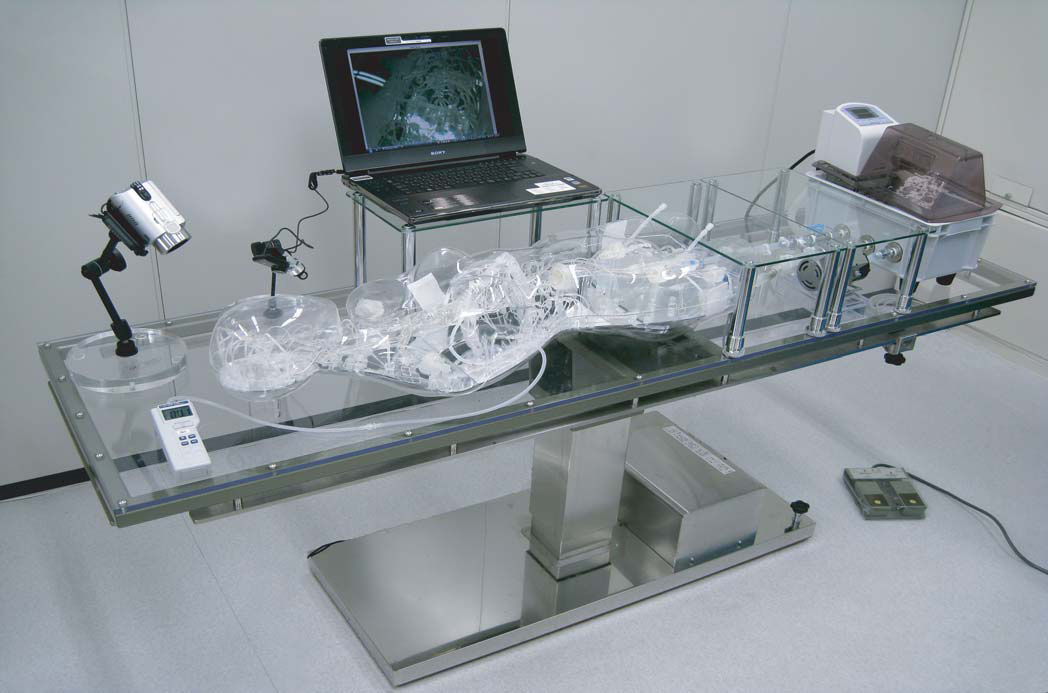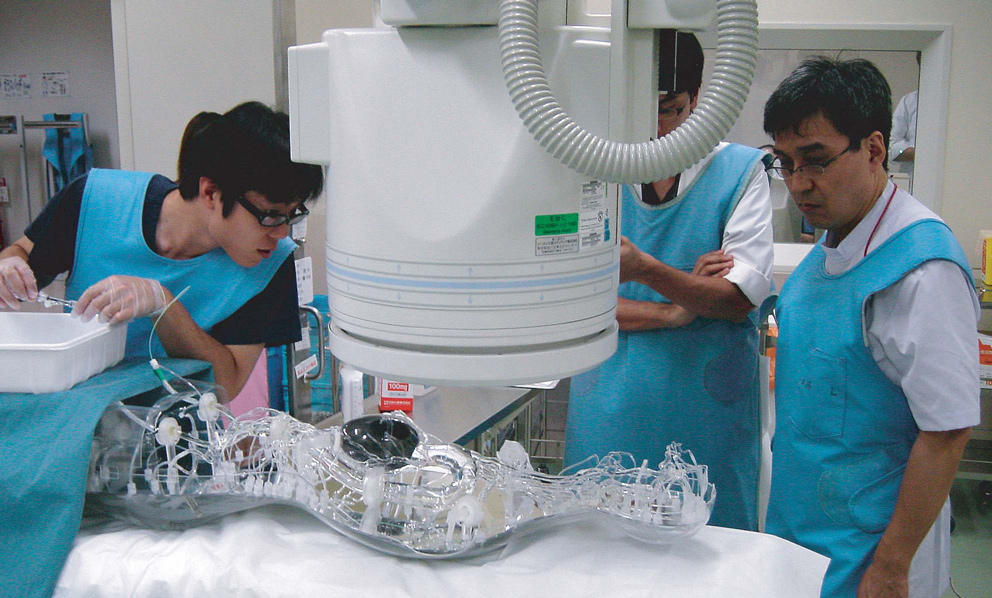
Robohub.org
Micro-robotics and medicine: Interview with Toshio Fukuda
 An international leader in the field of robotics and automation, Toshio Fukuda is best known for his pioneering work on micro robotics systems — including microsensors and micro actuators — and his medical intravascular microsurgery simulator has found commercial use. We caught up with Prof. Fukuda following the 2013 IROS conference in Tokyo, which Fukuda co-founded in 1988, to ask him about his groundbreaking work and the role of robotics in medicine.
An international leader in the field of robotics and automation, Toshio Fukuda is best known for his pioneering work on micro robotics systems — including microsensors and micro actuators — and his medical intravascular microsurgery simulator has found commercial use. We caught up with Prof. Fukuda following the 2013 IROS conference in Tokyo, which Fukuda co-founded in 1988, to ask him about his groundbreaking work and the role of robotics in medicine.
Welcome to Robohub, Toshio Fukuda. Can you tell us about your research?
In my lab at Nagoya University we do many different kinds of research: micro/nano robotic systems, medical robotics, and particularly medical simulators. We have many people working on medical robots and surgery robots right now. We are working on an intravascular robotic surgical system that could be used for brain surgery, for example, but one of our important areas is simulation-based medicine.
Let me explain simulation-based medicine … Before a medical doctor goes into surgery, he has to plan the surgery, and he used to have to do this in his own mind. But now he can use our simulator. For example, if you could practice an exam before taking it for real, you would be more likely to get a good score. Likewise, a medical doctor can use our simulator to rehearse his surgical plan so that when it is time for surgery, he can carry it out with confidence. This is especially important for intravascular surgery, where you have a team of doctors doing the surgery together.

Our simulator is not just for general purpose: we can create patient-specific models. We developed a system called EVE – it is short for EndoVascular Evaluator. It is for training, evaluation and simulation of endovascular surgery. We start by taking a CT scan of the patient and then we make physical model of the patient’s vascular system out of silicon using a 3D printing system. A fluid control unit is then used to simulate the patient’s circulation. Doctors can test their surgical plans on this simulator – it gives them the sensation of a real endovascular surgery.
I think this is the only such simulator available in the world so far. Of course there are virtual-reality-based simulators, and these can be good enough for a beginner, but there is a big difference between a virtual-reality-based simulator and a real physical simulator that can be used by a professional. It makes a big difference if a group of medical doctors can get together and make a plan in advance on how to carry out the surgery using a surgical model where they can see it and practice together on it … In a real situation, if you make a mistake, you have to stop what you are doing and sometimes you cannot carry out the surgery. This way a team of surgeons can make a careful plan in advance.
We have done this since 1998, and we have a built business from it since 2005… we have a company now called FAIN-Biomedical and are selling to the US, Italy, South Africa and also China, Korea and other places.

Can this system be used for training, too?
Of course you can use the simulator to train, but the big advantage is rehearsing just before surgery.
You have done micro-robotics for a long time. Can you tell us about that?
For intravascular surgery, you use a catheter; catheters are small wires about 1mm in diameter that can fit inside a patient’s brain veins. Also we are now expanding to the liver and to the heart, to do bypass surgery …
Your heart has 15 main blood vessels. These are very small and if one of them gets choked up, then you have a strain and the heart does not work properly. The doctor usually carries out bypass surgery, bypassing the choked up place to unblock the problem. That’s the conventional way. But with bypass surgery you have to open up the patient’s chest and then after that you have to close it up again and it takes a couple of weeks to recover from it. However in theory it’s just a catheter surgery that takes one or two hours and after that the patient can walk away from the hospital the same day or the next day. That’s what we call minimally invasive surgery or MIS and it’s becoming very popular because it doesn’t give much burden to the patient. Even after catheter surgeries in the brain or the heart the patient can walk away from the hospital the same day or next day.
The problem is that the doctor must have good skills to navigate the catheter, for example in brain surgery, from the thigh up to the brain where he uses a coil to remove the blockage. For this you need to be skilled, and if you make a mistake, there is no way to fix it.
I have been working with micro-robots for many, many years now. When I moved to Nagoya 25 years ago, a medical doctor came to me and looked at my micro-robots. At that time I had a small 7mm diameter micro-robot going inside of a tube, a kind of low-impact robot. This doctor looked at my robot and asked me if I could build a similar robot to be used for medical treatments in the blood vessels. But it’s not easy to make a 1mm- or 2mm-diameter robot that works inside a catheter. The head of the catheter can be shaped in such a way that it can make right or left turns, the same as steering functions. But there aren’t any commercial products yet … for more than 20 years people have been working on making a functional robotic catheter, but nothing has been commercialized yet. So companies like Johnson & Johnson or Boston Scientific, they don’t sell it yet.
Why is that? What’s the obstacle?
Because of reliability. Also, one catheter costs $2000 and is for only one-time use. In surgery, up to four or five catheters might be used and that brings the cost already to $10,000. But more important is the patient safety: patients are exposed to x-ray during the procedure to guide the catheter and many catheters means the patient will be exposed to the x-ray longer.
Is there a natural connection between micro-robotics and medicine?
Yes, of course … because micro-robots are small and the human blood vessels are also small. If you make robots too big, there are many procedures you cannot do. Think of it in terms of an endoscope: if an endoscope is big it can cause pain. But endoscopes are getting smaller and smaller, and some you can even swallow. As robots get smaller, that’s a good thing from a medical perspective, because they can therefore go more deeply into the human body … even the eyes for corneal surgery.
Think even of the Da Vinci … why is it good? Because the human finger is so big … maybe 10mm in diameter, but the Da Vinci device is 3-5mm in diameter and can get inside the body to reach much smaller places than the human hand with less burden to patients.
Does the application of medicine push the field of robotics to be more interdisciplinary?
Yes, medical robotics is a very interdisciplinary area. For example Pierre Dupont conducts research at Boston University and is also now working at the Children’s Hospital. He is not a medical doctor; he is a robotics scientist. Many people in my field work the same way … engineers going into the medical field and making micro-robotics tools to help people and save their lives. If you visit universities engaged in robotics, you will find at least one person working on medical robots. More than 20 years ago, my friend demonstrated using an industrial robot for biopsy or cutting of bone – specifically the hipbone. Many people, especially the elderly, have hipbone joint problems that could be helped with an artificial joint. And sometimes robots can do a better job than the doctors of cutting the bone very precisely … though of course the doctor has to have good knowledge of the subject and operation, and the robot, as I have said, is just a tool.
Medical robotics is a very competitive field. Germany, France, Japan, US … everywhere.
Do you also see people moving from the other direction, from medicine into robotics?
Yes, there are not so many, but there are some. I have met some medical doctors who are very enthusiastic to use robotic technologies for surgeries.
Professor Yamato, who gave one of the plenary lectures at IROS this year, would be a good example?
Yes, he is a good friend, and a medical doctor who is self-taught in robotics … he understands engineering. Other people are also looking mechanical robotic systems for surgery … maybe they are doing complicated surgeries and want to use more advanced technology, so they are making advances.
Before we finish, I was hoping you could tell us briefly about your recent trip to the Philippines after the typhoon … You were there on behalf of IEEE?
I’m a director of IEEE’s Region 10 – this is the Asia Pacific Region, including Japan, China, South Korea, New Zealand, Australia and other countries. After the typhoon I flew to Manila to meet with the local Region 10 officer and the chairman of the Philippines section of IEEE. The typhoon destroyed all the houses and infrastructure in the affected area; it was completely destructive. So we are working together on humanitarian technology program. We don’t give water or food … we give technology-based support. Like Internet recovery, energy and such things.
We have a lot of knowledge in this area from other disasters like the earthquake that befell a big province in Pakistan several years ago. Using experiences like this one in Pakistan or the tsunami in Indonesia, we are now making a list of priorities of what we should do to assist them. In most cases what we need first is to restore communication, Internet … after the typhoon in the Philippines there was no electricity and we therefore needed solar panels to keep the PCs working.
Is disaster response an especially important area for robotics in your region?
Yes, of course. There are disaster robot teams in Japan and also in IEEE Robotics and Automation Society, there is a technical committee, and we also have a humanitarian technology conference in Region 10. But in the Philippines case, disaster robot systems have played a very minor role so far. Priority is gathering information and restoring communication. In the first stage after a disaster, this is very, very important. But we are looking at later stages when we can bring some robots for taking care of people.
When will that happen?
We will be there in a couple of months … we have to hurry up. People need order to live. For security we want to bring robots to do monitoring, and to take care of the people from a psychological aspect, too. Many people have no houses to live in … it doesn’t feel good. For example we can bring PARO. PARO was made by Dr. Takanori Shidata, who was my graduate student in my lab at Nagoya … we want to bring this kind of robot to the Philippines. The PARO was also used here in Japan after Fukushima to help people with psychological aspects of recovery.
There are various stages where robotics can help after a disaster. We are making our priorities now.
Thank you Toshio for your time!
You are welcome.
If you liked this article, you may also be interested in:
- Minimally-invasive eye surgery on the horizon as magnetically-guided microbots move toward clinical trials
- Crowdsourcing new strategies for cancer treatment: Towards swarming nanobots
- Medical robotic systems market to reach $13.6 billion by 2018
See all the latest robotics news on Robohub, or sign up for our weekly newsletter.
tags: c-Health-Medicine, cx-Research-Innovation, interview, IROS2013, Micro, Service Professional Medical Surgery


